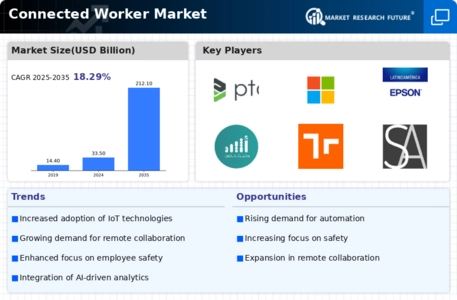Rise of Remote Work Solutions
The Connected Worker Market is witnessing a significant rise in remote work solutions, driven by the evolving nature of work environments. As organizations adapt to flexible work arrangements, the demand for technologies that support remote collaboration and connectivity is increasing. This shift is reflected in the market, where remote work solutions are expected to account for a substantial portion of the Connected Worker Market by 2026. Companies are investing in tools that enable employees to work effectively from various locations, ensuring that productivity remains high. The integration of virtual collaboration platforms and mobile applications is facilitating this transition, allowing workers to stay connected regardless of their physical location.
Emphasis on Data-Driven Decision Making
In the Connected Worker Market, there is a growing emphasis on data-driven decision making. Organizations are increasingly leveraging data analytics to enhance operational efficiency and improve worker performance. The ability to collect and analyze data from connected devices enables companies to identify trends, optimize processes, and make informed decisions. Recent statistics indicate that businesses utilizing data analytics in the Connected Worker Market have seen productivity improvements of up to 20 percent. This trend is likely to continue as more companies recognize the value of data in driving strategic initiatives. By harnessing data, organizations can not only enhance their operational capabilities but also foster a culture of continuous improvement among their workforce.
Focus on Enhanced Training and Development
The Connected Worker Market is increasingly focusing on enhanced training and development initiatives. Organizations recognize that equipping workers with the necessary skills is crucial for maximizing the benefits of connected technologies. As a result, there is a growing investment in training programs that leverage virtual reality and augmented reality solutions. These innovative training methods are designed to provide immersive learning experiences, which can lead to improved retention and application of skills. Recent studies suggest that companies implementing advanced training solutions in the Connected Worker Market have reported a 30 percent increase in employee engagement and performance. This focus on continuous learning is likely to shape the future workforce, ensuring that employees are well-prepared to navigate the complexities of modern work environments.
Increased Investment in Safety Technologies
The Connected Worker Market is seeing increased investment in safety technologies, reflecting a heightened awareness of workplace safety. Organizations are prioritizing the health and well-being of their employees by adopting connected safety solutions. These technologies include wearable devices that monitor worker health and environmental conditions, providing real-time alerts to potential hazards. Recent data indicates that the market for safety technologies within the Connected Worker Market is expected to grow by 25 percent over the next few years. This trend is driven by regulatory requirements and a commitment to fostering a safe work environment. By investing in these technologies, companies not only comply with safety standards but also enhance employee morale and productivity.
Integration of Advanced Communication Tools
The Connected Worker Market is experiencing a notable shift towards the integration of advanced communication tools. These tools facilitate real-time collaboration among workers, enhancing productivity and operational efficiency. As organizations increasingly adopt cloud-based platforms, the demand for seamless communication solutions rises. According to recent data, the market for communication tools in the Connected Worker Market is projected to grow at a compound annual growth rate of 15 percent over the next five years. This growth is driven by the need for remote collaboration and the increasing complexity of tasks that require immediate feedback. Furthermore, the integration of these tools supports a more agile workforce, allowing companies to respond swiftly to market changes and operational challenges.

















Leave a Comment